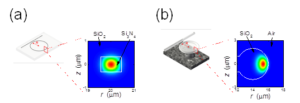Achieved the world's lowest power in an all-optical switch using the optical Kerr effect
Research
Achieved the world's lowest power in an all-optical switch using the optical Kerr effect
How much can the power required for the switch be reduced?
Many all-optical switches have been realized to date. All-optical switches based on micro optical resonators fabricated by semiconductors are superior in terms of integration and energy consumption, but they suffer from losses due to carrier generation used in switching operations. This loss can be a problem when switches are used in loss-sensitive applications such as quantum information communications, or when switches are cascaded. The optical Kerr effect, which does not involve carrier generation, can be used in switches to solve this problem, but the high optical power required to generate the effect has been an issue. In this research, the power required to generate the optical Kerr effect is significantly reduced by using a silicatroid resonator, and the world's lowest power optical switch using the optical Kerr effect has been successfully demonstrated.
Silicatroid resonators have an extremely high Q-value and a small mode volume, so it is expected that the optical Kerr effect can occur at low input power (Fig. 1). However, in addition to the optical Kerr effect, there is also a thermo-optic effect, which is caused by the heat generated by the absorption of light, in this resonator. Normally, the thermo-optic effect is larger than the optical Kerr effect, so it is not possible to selectively use only the optical Kerr effect. The optical Kerr effect has a much faster response time than the thermal response time.

Fig. 1 Scanning electron microscope image of a silica toroid microcavity.
Fig. 2 shows the experimental results. The solid blue line indicates the signal light output, and the gray area indicates the control light input. If an optical switch were implemented, the signal light output would turn ON only when the control light is input, and such behavior can be observed in Fig. 2. The response time of the switch was measured to be 6 ns, which is too short for a thermal response, so we can conclude that this result was obtained by the optical Kerr effect. The resonator used in Fig. 2 required a minimum power of 830 μW for the switch, as shown in the left panel of Fig. 3, but by using a resonator with a higher Q-value, the power was successfully reduced to 36 μW (right panel of Fig. 3). This is the lowest power among all optical car switches reported so far.

Fig. 2 All-optical switching operation based on Kerr effect. The solid blue line represents the signal output and the gray area indicates that the control light is inputted. The signal output is normalized by the off-resonance output. The red dotted line represents the signal output calculated by the The red dotted line represents the signal output calculated by the simulation.

Fig. 3 Minimum required control power for Kerr switching when a cavity with Q of 5×106 (left) and 4×107 (right) is employed.
- Categories
- 研究トピックス



